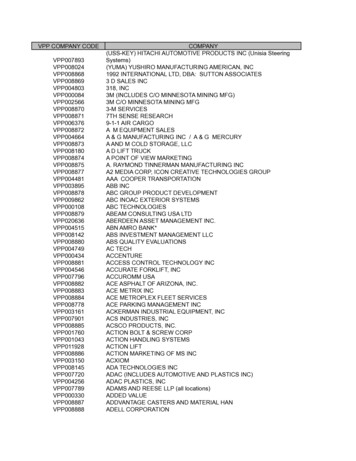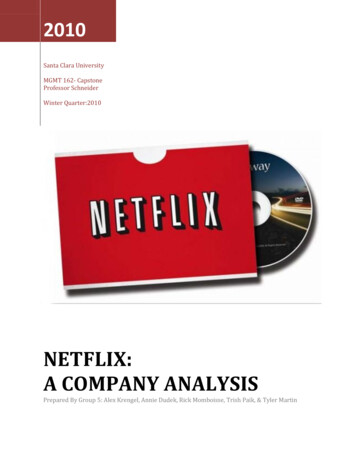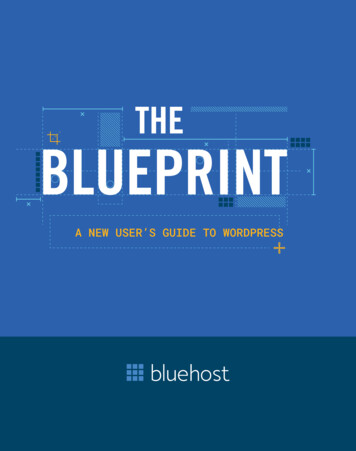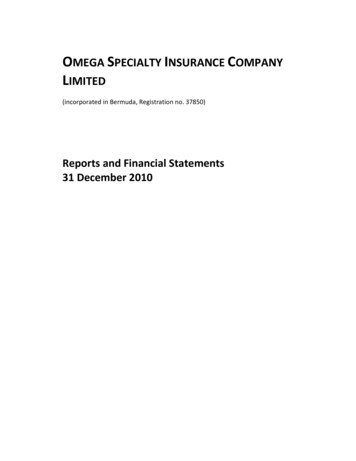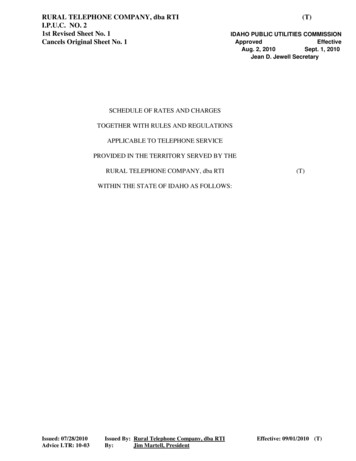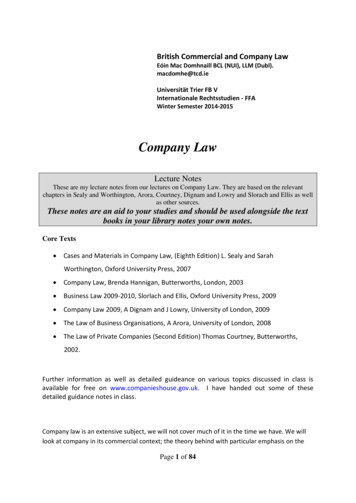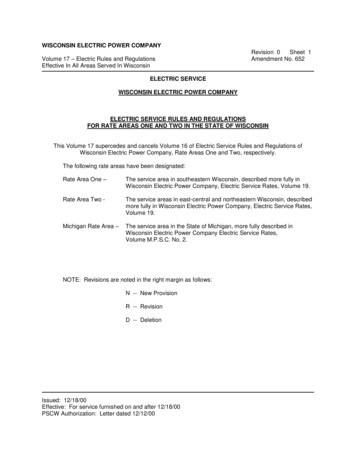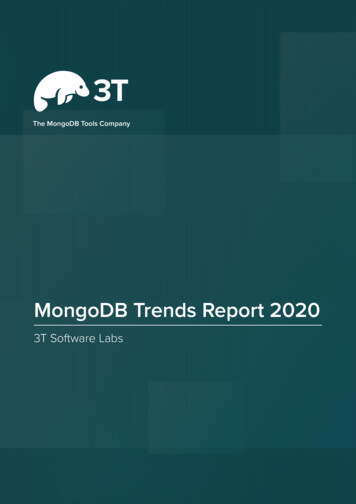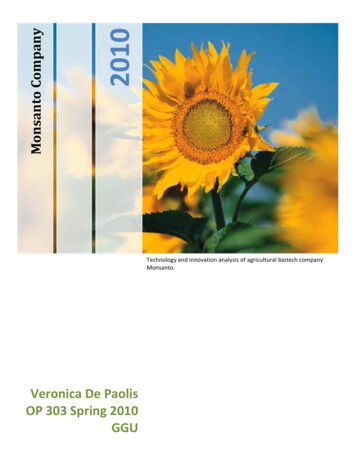
Transcription
2010Monsanto CompanyTechnology and innovation analysis of agricultural biotech companyMonsanto.Veronica De PaolisOP 303 Spring 2010GGU
ContentsExecutive Summary. 4Company Background . 4Value Proposition . 4Porter’s Five Forces Industry Analysis. 4Strategy . 4Recommendations . 4Background . 5Business. 5Products and Services . 6Performance Trends . 6Value Proposition . 7Value Chain . 7Value Net . 8Core Values . 8Business Model . 9Porter’s Five Forces Industry Analysis with Complementors . 9Key Competitors and Technologies . 11Resource Based Industry Structure. 12Business Strategy . 13Strategic Intent . 13Business Design . 14Core Competency. 14Value Migration . 14Product Pipeline and Life Cycle . 14Hypercompetition . 16Game Theory Strategy . 16Blue Ocean Strategy . 16R&D Costs and Revenue. 17Innovative Capabilities . 17Managerial Capabilities. 18SWOT Analysis. 18
Strengths . 18Weaknesses . 19Opportunities . 19Threats . 20Marketing Strategy . 21Recommendations . 21Appendix . 22Bibliography . 23
Executive SummaryCompany BackgroundMonsanto is an agricultural biotechnology company with operations in over 80. In 1945Monsanto first began production of agricultural chemicals. In 1982 Monsanto scientists were thefirst to genetically modify a plant cell. Today’s Monsanto was split off from the originalMonsanto Company, now Pharmacia Corporation and a subsidiary of Pfizer since 2003, in 2000.The firm has two major business segments seeds and traits, and agricultural productivity. Sinceits first genetic modification of plants in the 1980’s the firm has focused on genetic modificationto produce corn, soybean, cotton, and other seeds for sale all over the world.Value PropositionMonsanto’s value proposition is higher yields, primarily from large acre crops, through genetictraits, seed, and herbicide products. Monsanto’s products also provide the benefits of lower costsand higher nutrition to end consumers of Monsanto crop brands. In its vegetable seeds segmentMonsanto primarily focuses on improving flavor and nutrition.Porter’s Five Forces Industry AnalysisMonsanto’s major industry competitors are Syngenta and Bayer AG CropScience. Bothcompanies have more diverse product portfolios than Monsanto. The customers of products inthis industry are primarily farmers, not individual end consumers making the industrypredominantly B2B. Major suppliers in this industry organic and inorganic chemicalmanufacturers, and medical instruments and supplies manufacturers. The biotechnology industryis highly regulated and has very highly valued intellectual property making substitute productsdifficult to produce. Barriers to entry in this industry are medium and increasing. The agriculturebiotech industry is a rich ground for complementary products, chiefly companies producingpesticides that are complementary to their crop seed.StrategyMonsanto was able to achieve the market penetration by offering steep discounts to small seedproducers who entered contracts to keep Monsanto as their primary supplier. Monsanto’s intentis to continue to gain market share globally in the agriculture biotech industry. Monsanto’sproduct strategy focuses on grain yield, quality, environmental stress tolerance, pest control,herbicide tolerance, disease resistance, etc. The company has a strategy of closed innovation asthe industry is highly competitive and knowledge-based.RecommendationsMonsanto should aggressively expand its product portfolio by entering new industries in biofuelsand pharmaceuticals. Another recommendation Monsanto cannot ignore is to bolster its PRefforts. Litigation cannot be ignored and Monsanto should put more stringent technical andbusiness practices standards in place in order to avoid legal issues.
BackgroundMonsanto is an agricultural biotechnology company with operations in over 80 countries that is asubsidiary of Pharmacia Corporation, a subsidiary of Pfizer (Monsanto, 2010). Monsanto holds4.1% of the market share in the U.S. biotechnology industry, which includes major players suchas Genentech (IBISWorld, 2010). Monsanto was originally founded in 1901 and its first productwas saccharine, an artificial sweetener which the company successfully sold to Coca Cola.In 1945 Monsanto first began production of agricultural chemicals. In 1982 Monsanto scientistswere the first to genetically modify a plant cell.The agriculture division continued growingthrough acquisition and innovative research through 1998. Today’s Monsanto was split off fromthe original Monsanto Company, now Pharmacia Corporation and a subsidiary of Pfizer since2003, in 2000. Monsanto Company is a major player in several sectors of industry such as cornfarming (with 6.4% market share), fertilizers and agricultural chemicals (3.5% market share),phosphate and other mineral mining (3.5% market share), and pesticide manufacturing (12%market share) (IBIS World).The firm has two major business segments. The first segment is Agricultural Productivity, whichconsists of Monsanto’s glyphosate products. One of its early products, Monsanto’s glyphosatesinclude commercial herbicide Roundup as well as many other herbicides. Monsanto’s secondmajor segment is Seeds and Genomics. Since its first genetic modification of plants in the1980’s the firm has focused on genetic modification to produce corn, soybean, cotton, and otherseeds for sale all over the world. Its major seed products include Roundup- and other glyphosateherbicide-resistant corn, canola, soybean, and cotton seeds.BusinessWith the exception of commercially available Roundup herbicide Monsanto sells almostexclusively wholesale seeds and chemicals. The company has two business segments: Seeds andTraits and Agricultural Productivity (Monsanto Company, 2010). Monsanto also licenses the useof its patented genes by other seed companies. Monsanto’s patented genes are found in 95% ofsoybeans and 80% of corn grown in the U.S. (Leonard, 2009). Monsanto is able to generatesignificant revenues due primarily to its innovations in patenting genes and traits found in itsseeds. Though now off patent and available in generic form Roundup was one of Monsanto’skey products for many years. The powerful defoliant herbicide was one of Monsanto’s strongestbrands and a significant source of revenue. Now that competitors are able to use the sametechnology and inputs to make similar herbicides Monsanto has had to lower prices on Roundupproducts significantly. Today Monsanto relies on its crop plant genes and traits for the majority
of its revenues. These products include traits that make crops resistant to insects, adverseclimate, and herbicides. In fact Roundup Ready is now Monsato’s most popular brand because itmakes crop plants resistant to the defoliating effects of Roundup at all stages of growth.Products and ServicesMonsanto has various brands within its two product segments. In its seeds and traits segmentMonsanto’s products include genetic traits that protect plants from pests and weeds, commercialcrop seeds including corn and soy, and vegetable seeds (Monsanto Company, 2010).Monsanto’s top seed and trait brands include Acceleron, Asgrow, Dekalb, Deltapine, De RuiterSeeds, Genuity, Roundup Ready, Seminis, Vistive, and YieldGard. Through these brandsMonsanto sells corn, cotton, soy, canola, wheat, and vegetable seeds and seed traits. Monsanto’sagricultural productivity business segment sells industrial herbicides for agricultural and turf andornamental applications (such as in parks) as well as the popular consumer herbicide Roundup.Monsanto’s different products and brands are designed to work together, for example Roundupherbicides with Roundup Ready seeds, designed to be resistant to the defoliating effects ofRoundup.Monsanto also licenses its genes and traits to smaller companies that produce seeds and haveestablished distribution channels to farmers. Licensing genes and traits is a strategy not pursuedby any other major competitors in the industry. Monsanto is able to safely license technologiesdue to extremely strong intellectual property rights protection. Monsanto allows license holdingpartners to sell competing traits, for example the first and second generations of a RoundupReady trait (Monsanto Company, 2010). Monsanto’s traits are in high demand among farmersso licenses benefit licensees by allowing them to insert desired traits into their own seedproducts.Performance TrendsIn the last five years Monsato’s stock price rose dramatically from the period 2005 to late 2008then fell slightly and has remained fairly stable until the present. Monsanto’s revenue grew 44%from 2007 to 2008, and 9% from 2008 to 2009 while its net income grew by 103% from 2007 to2008 and 4% from 2008 to 2009. The firm’s operating income increased 91% from 2007 to2008 and by 14% from 2008 to 2009. Though the rate of growth from 2007 to 2008 for mostindicators was much greater than the rates for the period from 2008 to 2009 all indicators showpositive
Monsanto is an agricultural biotechnology company with operations in over 80. In 1945 Monsanto first began production of agricultural chemicals. In 1982 Monsanto scientists were the first to genetically modify a plant cell. Today’s Monsanto was split off from the originalFile Size: 635KBPage Count: 24

![Shareholders’ Agreement of [Company name] company. 1 .](/img/1/startup-founders-sha-sample.jpg)
